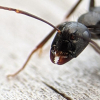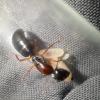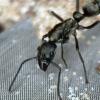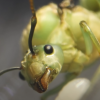They were originally a mass of ants and brood in the outworld before they finally moved into the test tube. ![]()
Edited by Gregory2455, November 29 2014 - 8:06 PM.

They were originally a mass of ants and brood in the outworld before they finally moved into the test tube. ![]()
Edited by Gregory2455, November 29 2014 - 8:06 PM.
The smaller colony has some blue larvae from the Blue 100 I have been feeding them. The larger colony hardly has any brood, which may be the reason they are not eating much. I am planning to cook up an Aqua 300 for these, the Crematogaster, and some of my other sweets loving ants.
Update: 12/10/2014
The smaller colony has filled up nicely on Blue 100. ![]()
The larger colony still refuses to eat. ![]()
I just noticed what is a new clutch of brood containing about 200 eggs and small larvae in the larger colony! ![]()
I just found two smaller clutches, one of which is very fresh. The larger one probably consists of 25, while the smaller one (which seems to be being added to, so the queen has been laying eggs in the very minutes before this post) has about 10 eggs and counting.
Update: 1/31/2015
Both colonies were moved into some new "boxbox" containers. ![]()
Update: 2/3/2015
Just a video update on both of these colonies.
Large colony: They have grown, and in December, laid about 300 eggs, most of which were sadly trophic eggs (infertile eggs used as food for workers or larvae). There is still a very large brood pile however, so there will be a lot of new workers soon.
Small colony: Some kind of fog or something is growing pretty close to the cotton on the glass, but it may just be formic acid from the ants. They are showing decent growth.
Update: 3/5/2015
Like Drew's colony, my larger colony is dying out. My smaller colony has not had a casualty since about November, meanwhile 2-3 workers are dying daily in my large colony, which was getting very close, if not over 100 workers. ![]() Soon, the two colonies will be the same size.
Soon, the two colonies will be the same size.
Edited by Gregory2455, March 5 2015 - 9:25 PM.
Update: 3/17/2015
The large colony continues to suffer, now down to about 15 workers, but they now have an egg pile of about 50. This is to be called 'Colony #1'.
The original "small" colony now has about 20 workers, so is now larger than my original colony. ![]() This will be called 'Colony #2'.
This will be called 'Colony #2'.
Colony #1 is now only at six workers... ![]()
Update:5/31/2015
The original colony died about a month ago, I just forgot to update. Colony #2 is still growing but has lost a few workers recently.
Greg, Do you think that they are poly, i caught two and i put them together in a test tube. They seem to get along except one seems to show dominance. ![]()
Update: 12/10/2015
This last colony is flourishing. I think they are up to 50 workers and 50 brood. ![]()
Nice to see at least one of your colonies is still alive. ![]()
I like this jaunty little ant, and you've posted some interesting observations on them, Gregory. There speed is the main reason why people call them "crazy ants", though I think "running ants" would be more accurate.
A couple of things:
- There is no reason to call these "cf. vividula". There is little or no doubt that the common urban Nylanderia species in your region is genuine N. vividula.
- I don't believe they actually drove out L. humile, but rather, opportunistically moved in as L. humile declined for other reasons, which it has for other, not completely understood reasons in various places.
Ant Keeping →
Ant Keeping Journals →
cooIboyJ's Nylanderia vividula journalStarted by cooIboyJ , Sep 6 2025 |
|

|
||
Ant Keeping →
Ant Keeping Journals →
Ants_Dakota's Camponotus sp. JournalStarted by Ants_Dakota , Jul 13 2025 |
|

|
||
Ant Keeping →
Ant Keeping Journals →
Strickys Formica JournalStarted by stricky_ants , Jun 21 2025 |
|

|
||
Ant Keeping →
Ant Keeping Journals →
AntTx's Camponotus sansabeanus JournalStarted by AntsTx , Jun 17 2025 |
|

|
||
Ant Keeping →
Ant Keeping Journals →
The Bark Battalion (Liometopum occidentale)Started by AntsGodzilla , Jun 3 2025 |
|

|
0 members, 1 guests, 0 anonymous users